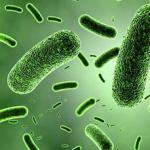1 slide

2 slide
low molecular weight organic compounds are necessary for the normal functioning of organisms and perform the following functions: - catalytic - regulatory Vitamins are essential organic microcomponents of food A. Lehninger.
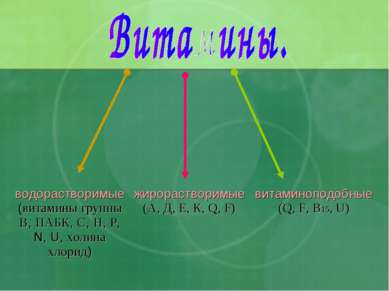
3 slide
water-soluble (vitamins B, PABA, C, H, P, N, U, choline chloride) fat-soluble (A, D, E, K, Q, F) vitamin-like (Q, F, B15, U)
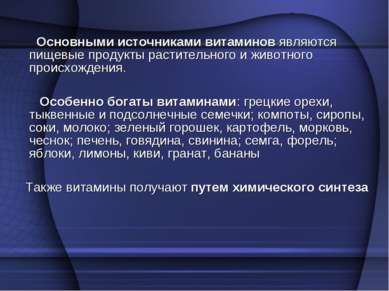
4 slide
The main sources of vitamins are food products of plant and animal origin. Particularly rich in vitamins: walnuts, pumpkin and sunflower seeds; compotes, syrups, juices, milk; green pea, potatoes, carrots, garlic; liver, beef, pork; salmon, trout; apples, lemons, kiwi, pomegranate, bananas Vitamins are also obtained by chemical synthesis
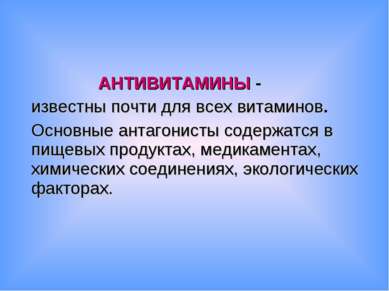
5 slide
ANTIVITAMINS - known for almost all vitamins. The main antagonists are found in foods, medicines, chemical compounds, environmental factors.

6 slide

7 slide
VITAMIN B (pantothenic acid, antidermatitis vitamin) - C9H17O5N Pantothenic acid (D (+) - 2, 4 - dioxy - 3, 3 - dimethylbutyryl - B - alanine) belongs to the group of B vitamins. Its name translated from Greek means “everywhere” ". Only the D isomer has vitamin activity. Vitamin B is an antidermatitis vitamin. Also, the biological role of pantothenic acid is determined by the participation in the construction of coenzyme A, a universal acceptor and carrier of acid groups, especially acetyl groups. Pantothenic acid is especially rich in liver, kidneys, egg yolk, caviar, as well as cauliflower, tomatoes, potatoes, grains, peanuts, in addition, it is synthesized by intestinal microflora. However, in cases of developed vitamin deficiency, rapid fatigue, dizziness, dermatitis, lesions of the mucous membranes, neuritis, visual disturbances(before complete blindness), gastrointestinal intestinal disorders.
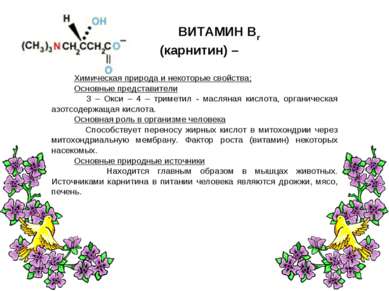
8 slide
VITAMIN Br (carnitine) – Chemical nature and some properties; The main representatives are 3 - Hydroxy - 4 - trimethyl butyric acid, organic nitrogen-containing acid. Main role in the human body Promotes the transfer of fatty acids into mitochondria across the mitochondrial membrane. Growth factor (vitamin) of some insects. Main natural sources Found mainly in animal muscles. Sources of carnitine in human nutrition are yeast, meat, and liver.
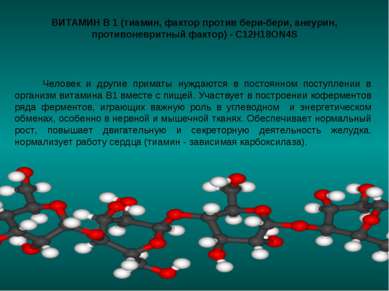
Slide 9
Humans and other primates need a constant supply of vitamin B1 through food. Participates in the construction of coenzymes of a number of enzymes that play an important role in carbohydrate and energy metabolism, especially in the nervous and muscle tissue. Ensures normal growth, improves motor and secretory activity stomach, normalizes heart function (thiamine-dependent carboxylase). VITAMIN B 1 (thiamine, anti-beriberi factor, aneurin, anti-neuritis factor) - C12H18ON4S

10 slide
VITAMIN B2 (riboflavin)-C17H20N4O6 Chemical nature and some properties; The main representatives are Riboflavin, or dimethyl - ribityl - isoalloxazine; It is poorly soluble in water, quickly destroyed by sunlight, and is one of the most widely distributed vitamins. Main role in the body Participates in the regulation of ORR (oxidation-reduction reactions), metabolism of fats, proteins and carbohydrates, in maintaining normal visual function eyes, is part of visual purple, protecting the retina from harmful action UV radiation affects the growth and development of the child's fetus. Major Natural Sources Riboflavin is found in all animal and plant cells, but few foods are rich sources of this vitamin. The highest concentrations of riboflavin are found in yeast and liver, but the most common dietary sources of riboflavin are milk and dairy products, meat, eggs, vegetables and greens. Cereal grains, although not very high in riboflavin, are important sources of this vitamin for those who rely on cereals as a major component of their diet. Fortified flour and flour products allow you to get enough vitamin B2. Riboflavin from animal products is absorbed better than from plant sources. In cow, sheep and goat milk, at least 90% of riboflavin is in free form; in most other sources it is found bound to proteins.

11 slide
Vitamin B3 (also called vitamin PP, nicotinic acid and nicotinamide) - has anti-pellagric properties, improves carbohydrate metabolism, has a positive effect on mild forms of diabetes, peptic ulcer stomach, duodenum and enterocolitis, for diseases of the liver and heart, for slowly healing wounds and ulcers, it is a vasodilator. The daily requirement is 18 mg.
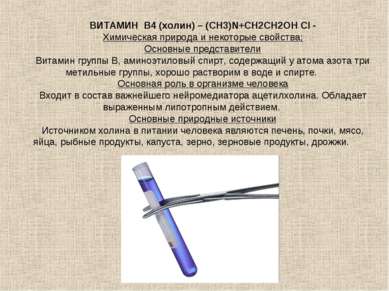
12 slide
VITAMIN B4 (choline) – (CH3)N+CH2CH2OH CI - Chemical nature and some properties; The main representatives of vitamin B, aminoethyl alcohol, containing three methyl groups at the nitrogen atom, are highly soluble in water and alcohol. Main role in the human body Part of the most important neurotransmitter acetylcholine. Has a pronounced lipotropic effect. Main natural sources The source of choline in human nutrition is liver, kidneys, meat, eggs, fish products, cabbage, grains, grain products, yeast.

Slide 13
Vitamin B5 (also calcium pantothenate) - participates in carbohydrate and fat metabolism and in the synthesis of acetylcholine, stimulates the formation of corticosteroids and the functioning of the adrenal glands. The daily requirement is 10-12 mg.
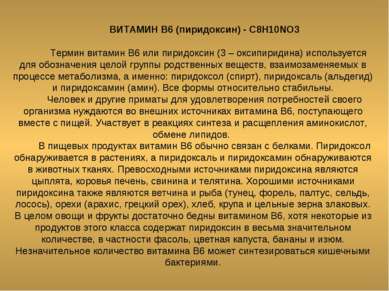
Slide 14
VITAMIN B6 (pyridoxine) - C8H10NO3 The term vitamin B6 or pyridoxine (3-hydroxypyridine) is used to designate a whole group of related substances that are interchangeable in the metabolic process, namely: pyridoxole (alcohol), pyridoxal (aldehyde) and pyridoxamine (amine). All forms are relatively stable. To meet the needs of their bodies, humans and other primates require external sources of vitamin B6, supplied with food. Participates in the reactions of synthesis and breakdown of amino acids, lipid metabolism. In foods, vitamin B6 is usually bound to proteins. Pyridoxole is found in plants, and pyridoxal and pyridoxamine are found in animal tissues. Excellent sources of pyridoxine include chicken, cow's liver, pork and veal. Good sources of pyridoxine are also ham and fish (tuna, trout, halibut, herring, salmon), nuts (peanuts, Walnut), bread, cereals and whole grain cereals. In general, vegetables and fruits are quite poor in vitamin B6, although some of the products in this class contain pyridoxine in very significant quantities, in particular beans, cauliflower, bananas and raisins. A small amount of vitamin B6 can be synthesized by intestinal bacteria.
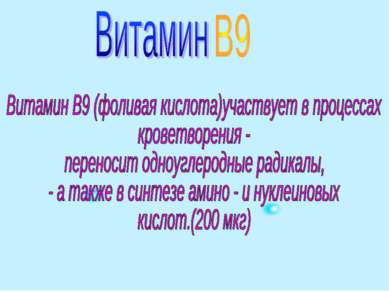
15 slide
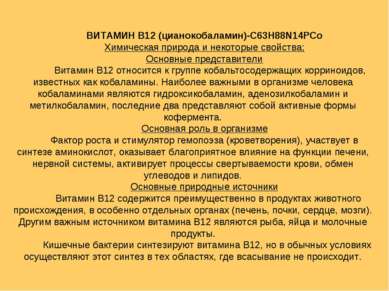
16 slide
VITAMIN B12 (cyanocobalamin)-C63H88N14PCo Chemical nature and some properties; Main representatives Vitamin B12 belongs to a group of cobalt-containing corrinoids known as cobalamins. The most important cobalamins in the human body are hydroxycobalamin, adenosylcobalamin and methylcobalamin, the latter two being active forms of the coenzyme. Main role in the body Growth factor and stimulator of hematopoiesis (blood formation), participates in the synthesis of amino acids, has a beneficial effect on liver function, nervous system, activates blood clotting processes, carbohydrate and lipid metabolism. Main natural sources Vitamin B12 is found mainly in foods of animal origin, especially in individual organs (liver, kidneys, heart, brain). To others important source vitamin B12 are fish, eggs and dairy products. Intestinal bacteria synthesize vitamin B12, but normal conditions carry out this synthesis in those areas where absorption does not occur.
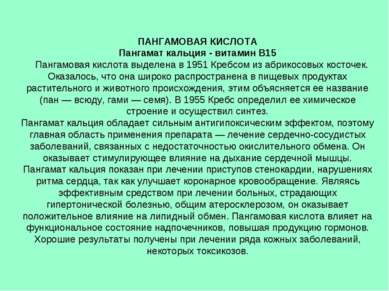
Slide 17
PANGAMIC ACID Calcium pangamate - vitamin B15 Pangamic acid was isolated in 1951 by Krebs from apricot kernels. It turned out that it is widespread in food products of plant and animal origin, which explains its name (pan - everywhere, gami - seed). In 1955, Krebs determined its chemical structure and carried out its synthesis. Calcium pangamate has a strong antihypoxic effect, so the main area of application of the drug is treatment cardiovascular diseases associated with insufficiency of oxidative metabolism. It has a stimulating effect on breathing heart muscle. Calcium pangamate is indicated for the treatment of angina attacks, cardiac arrhythmias, as it improves coronary circulation. Being effective means in the treatment of patients suffering hypertension, general atherosclerosis, it has a positive effect on lipid metabolism. Pangamic acid affects functional state adrenal glands, increasing hormone production. Good results obtained in the treatment of a number skin diseases, some toxicoses.
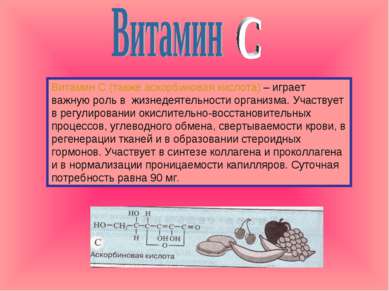
18 slide
Vitamin C (also ascorbic acid) plays an important role in the functioning of the body. Participates in the regulation of redox processes, carbohydrate metabolism, blood clotting, tissue regeneration and education steroid hormones. Participates in the synthesis of collagen and procollagen and in the normalization of capillary permeability. The daily requirement is 90 mg.
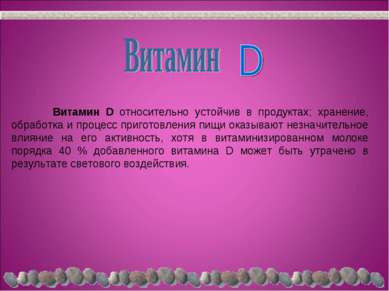
Slide 19
Vitamin D is relatively stable in foods; Storage, processing and food preparation processes have little effect on its activity, although in fortified milk about 40% of added vitamin D may be lost as a result of light exposure.
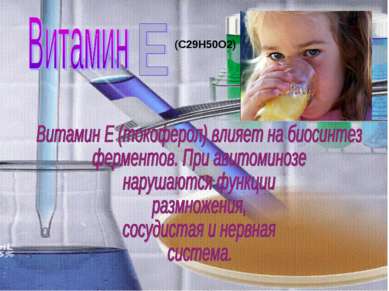
20 slide
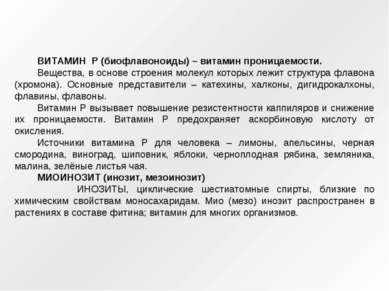
21 slides
VITAMIN P (bioflavonoids) – permeability vitamin. Substances whose molecular structure is based on the structure of a flavone (chromone). The main representatives are catechins, chalcones, dihydrocalchones, flavins, flavones. Vitamin P causes an increase in capillary resistance and a decrease in their permeability. Vitamin P protects ascorbic acid from oxidation. Sources of vitamin P for humans are lemons, oranges, black currants, grapes, rose hips, apples, chokeberry, strawberries, raspberries, green leaves tea. MYOINOSITOL (inositol, mesoinositol) INOSITOL, cyclic hexahydric alcohols, similar in chemical properties monosaccharides. Mio (meso) inositol is common in plants as part of phytin; vitamin for many organisms.
Presentation on the topic "Vitamins" in biology in powerpoint format. This presentation for 8th grade schoolchildren tells about the daily requirement, the importance of essential vitamins, the products in which they are contained, as well as signs of vitamin deficiency and hypervitaminosis for each vitamin described. The work contains 36 slides. Author of the presentation: Titova Marina Sergeevna, biology teacher.
Fragments from the presentation
VITAMINS(from the Latin “vita” - life, “amin” - containing nitrogen) - these are organic compounds that are constantly required in small quantities for the flow of bio chemical reactions in organism.
ENZYMES– THESE ARE PROTEIN CATALYSTS OF BIOCHEMICAL REACTIONS
VITAMINS
WATER SOLUBLE. VITAMINS OF GROUP B, C, P, PP, H
FAT SOLUBLE. VITAMINS A, D, E, K
VITAMIN C (ascorbic acid)
DAILY REQUIREMENT
- 70 - 100 mg.
- DURING A COLD OR ILLNESS 150 – 200 mg.
- Smokers and the elderly have an increased need for vitamin C (one cigarette smoked destroys 25 mg C).
MEANING
- Promotes wound healing
- Counteracts infections
- Increases iron absorption
- Has pronounced antioxidant properties
- Plays an important role in maintaining normal cardiovascular formation vascular system, liver and other organs.
AVITAMINOSIS
SCURVY- A disease caused by a lack of vitamin C in the body and manifested in loosening and bleeding of the mucous membrane of the gums, muscle-vascular pain, weakness
Hypervitaminosis
- Diarrhea
- Flatulence
- Abdominal pain
- Nausea
- Vomit
- Kidney stones
PRODUCTS
- rosehip (dry) 1200 mg.
- black currant 200 mg.
- parsley 190 mg.
- green pepper 100 mg.
VITAMIN B1 (thiamine)
Daily requirement
- 1.5 – 2.0 mg.
- Increased doses of the vitamin are necessary during illnesses and during the recovery period, during high physical activity, and for people with hyperfunction thyroid gland as well as children and the elderly.
Meaning
- participates in carbohydrate, energy, fat, protein and water-salt metabolism
- has a regulating effect on the activity of the nervous system
- improves mental abilities and mood
- optimizes brain function
- has a positive impact on growth
- normalizes appetite
- improves learning ability.
Avitaminosis
Take - take (polyneuritis)
Hypervitaminosis
- possible allergic reactions, spasms
- lowering blood pressure
- sometimes there is individual intolerance to vitamin B1 - urticaria and skin itching appear
- Long-term use in large doses can lead to disruption of the liver and kidneys.
Products
- Brewer's yeast 10,000 – 17,000 mg.
- Peanuts 750 mg.
- Dry legumes – 450 mg.
- Wheat cereal 450 mg.
Vitamin A (retinol)
Daily requirement
- The daily requirement for retinol is 1 mg
- For normal absorption of the vitamin, it is necessary to consume a sufficient amount of fat.
Meaning
- influences human growth and improves skin condition
- contributes to the body's resistance to infection
- ensures the growth and development of epithelial cells
- is part of the visual pigment of the rods of the retina - rhodopsin and the visual pigment of the cones - iodopsin.
Avitaminosis
- Dry mouth and dry skin may indicate vitamin A deficiency
- The most striking manifestation of vitamin A deficiency is the manifestation of “night blindness”, that is, the inability to see in the dark
Hypervitaminosis
Excess vitamin A in pregnant women leads to congenital deformities in newborns - Overdose vitamin complexes with vitamin A can lead to liver failure and even death.
Products
- Liver
- Parsley
- Fruits and vegetables red, or orange color(For example, carrots)
Vitamin D (calciferol)
Meaning
- Important for the absorption of calcium in the body´
- Helps maintain healthy bones and teeth
- Important for the immune system
Daily requirement
- for adults 2.5 - 5.0 mcg
- for children, depending on age and gender 2.5 - 10.0 mcg
- for infants 7.5 - 10.0 mcg
- The need for vitamin D is higher in people lacking ultraviolet radiation:
- living in high latitudes,
- residents of regions with high air pollution,
- working on the night shift or simply leading a nocturnal lifestyle,
- bedridden patients who do not spend time outdoors.
- In people with dark skin (Negroid race, tanned people), the synthesis of vitamin D in the skin is reduced.
Avitaminosis
- Children have rickets, spinal deformity,
- Delayed growth and development
- In adults, the development of osteoporosis
Hypervitaminosis
Excessive intake of vitamin D can lead to excess calcium concentrations. In this case, calcium can penetrate the walls of blood vessels and provoke the formation of atherosclerotic plaques.
Products
The main source of Vitamin D is direct exposure to the sun. Our skin produces this vitamin when exposed to the sun.
- Fatty fish
- Egg yolk
- Fish fat
Vitamin E (tocopherol)
Daily requirement
- An adult should consume about 10 mg of vitamin E per day.
- The need for vitamin E increases during pregnancy, intense physical work and in old age
Meaning
- Vitamin E is an antioxidant that helps protect cells from oxygen free radical damage
- The vitamin is of great importance for the reproductive system, which is why it is often called the “vitamin of reproduction.”
Avitaminosis
The main signs of its deficiency are apathy, dry skin and brittle hair. In addition, fine wrinkles and age spots appear on the skin, and skin diseases, such as eczema, may appear and worsen.
Hypervitaminosis
Vitamin E is practically safe and non-toxic. But taking large doses of the vitamin can cause nausea and stomach upset.
Products
- Vegetable oils
- Nuts and grains
- Egg yolk
- Some types of fatty fish
Slide 1
Slide 2
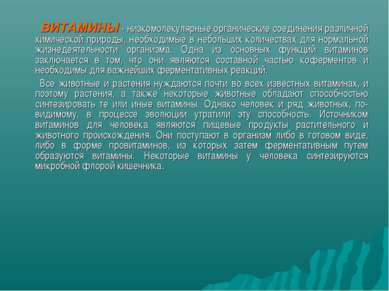 VITAMINS are low molecular weight organic compounds of various chemical natures, necessary in small quantities for the normal functioning of the body. One of the main functions of vitamins is that they are part of coenzymes and are necessary for essential enzymatic reactions. All animals and plants need almost all known vitamins, and therefore plants, as well as some animals, have the ability to synthesize certain vitamins. However, humans and a number of animals apparently lost this ability in the process of evolution. The source of vitamins for humans are food products of plant and animal origin. They enter the body either in finished form or in the form of provitamins, from which vitamins are then formed enzymatically. Some vitamins in humans are synthesized by intestinal microbial flora.
VITAMINS are low molecular weight organic compounds of various chemical natures, necessary in small quantities for the normal functioning of the body. One of the main functions of vitamins is that they are part of coenzymes and are necessary for essential enzymatic reactions. All animals and plants need almost all known vitamins, and therefore plants, as well as some animals, have the ability to synthesize certain vitamins. However, humans and a number of animals apparently lost this ability in the process of evolution. The source of vitamins for humans are food products of plant and animal origin. They enter the body either in finished form or in the form of provitamins, from which vitamins are then formed enzymatically. Some vitamins in humans are synthesized by intestinal microbial flora.
Slide 3
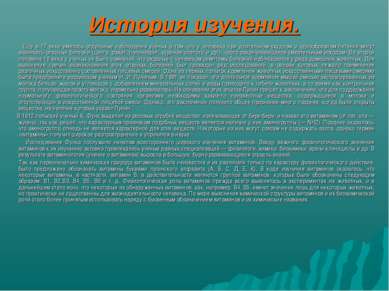 History of the study. Back in the 17th century, there were separate observations by scientists that a person with prolonged poor and monotonous nutrition may experience dangerous diseases(scurvy, rickets, polyneuritis, night blindness, etc.), often resulting in death. In the second half of the 19th century, scientists had no doubt that disease symptoms similar to humans were observed in a number of domestic animals. To find out the causes of these dangerous diseases, a number of studies were conducted, which were based on the use of various artificially formulated food mixtures. One of the first attempts to feed animals with artificial food mixtures was made by the Russian scientist N.I. Lunin. In 1881, he showed that long-term feeding of mice with a mixture of proteins, fats and carbohydrates extracted from milk with the addition of mineral salts and water led to the death of the animals, while the control group receiving just milk developed normally. Based on these experiments, Lunin came to the conclusion that in order to maintain the normal physiological state of the body, some unknown substances contained in milk and absent in the artificial food mixture are necessary. However, this conclusion received general recognition much later, when the substances whose presence Lunin indicated were discovered. In 1912, the Polish scientist K. Funk isolated a substance that cures beriberi from rice bran and called it vitamin (from the Latin vita - life), because he decided that characteristic feature similar substances is the presence of an amino group (- NH2). Later it turned out that the amino group is by no means characteristic of these substances. Some of them may contain no nitrogen at all, but the term “vitamins” has become widespread and established in science. Funk's research marked the beginning of a comprehensive and extensive study of vitamins. Due to the important physiological significance scientists of various specializations - physiologists, chemists - were actively involved in their study of vitamins. biochemists. clinicians, etc. As a result, vitaminology (the study of vitamins) has grown into a large, rapidly developing branch of knowledge. Since initially the chemical nature of vitamins was unknown and they were distinguished only by their nature physiological action, it was proposed to designate vitamins with letters of the Latin alphabet (A, B, C, D, E, K). In the course of studying vitamins, it turned out that some vitamins, in particular vitamin B, are actually a group of vitamins, which were designated as follows: B1, B2, B3, B4, B5, B6, etc. The physiological role of vitamins was primarily clarified in experiments on animals, and later it became clear that some of the discovered vitamins, such as B4, B5, are important only for some animals, but are practically insignificant for human life. As the chemical structure of vitamins and their biochemical role became clearer, it became more common to use their chemical names along with the letter designation of vitamins.
History of the study. Back in the 17th century, there were separate observations by scientists that a person with prolonged poor and monotonous nutrition may experience dangerous diseases(scurvy, rickets, polyneuritis, night blindness, etc.), often resulting in death. In the second half of the 19th century, scientists had no doubt that disease symptoms similar to humans were observed in a number of domestic animals. To find out the causes of these dangerous diseases, a number of studies were conducted, which were based on the use of various artificially formulated food mixtures. One of the first attempts to feed animals with artificial food mixtures was made by the Russian scientist N.I. Lunin. In 1881, he showed that long-term feeding of mice with a mixture of proteins, fats and carbohydrates extracted from milk with the addition of mineral salts and water led to the death of the animals, while the control group receiving just milk developed normally. Based on these experiments, Lunin came to the conclusion that in order to maintain the normal physiological state of the body, some unknown substances contained in milk and absent in the artificial food mixture are necessary. However, this conclusion received general recognition much later, when the substances whose presence Lunin indicated were discovered. In 1912, the Polish scientist K. Funk isolated a substance that cures beriberi from rice bran and called it vitamin (from the Latin vita - life), because he decided that characteristic feature similar substances is the presence of an amino group (- NH2). Later it turned out that the amino group is by no means characteristic of these substances. Some of them may contain no nitrogen at all, but the term “vitamins” has become widespread and established in science. Funk's research marked the beginning of a comprehensive and extensive study of vitamins. Due to the important physiological significance scientists of various specializations - physiologists, chemists - were actively involved in their study of vitamins. biochemists. clinicians, etc. As a result, vitaminology (the study of vitamins) has grown into a large, rapidly developing branch of knowledge. Since initially the chemical nature of vitamins was unknown and they were distinguished only by their nature physiological action, it was proposed to designate vitamins with letters of the Latin alphabet (A, B, C, D, E, K). In the course of studying vitamins, it turned out that some vitamins, in particular vitamin B, are actually a group of vitamins, which were designated as follows: B1, B2, B3, B4, B5, B6, etc. The physiological role of vitamins was primarily clarified in experiments on animals, and later it became clear that some of the discovered vitamins, such as B4, B5, are important only for some animals, but are practically insignificant for human life. As the chemical structure of vitamins and their biochemical role became clearer, it became more common to use their chemical names along with the letter designation of vitamins.
Slide 4
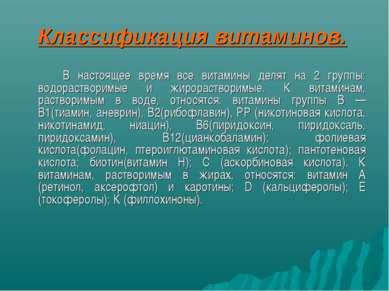 Classification of vitamins. Currently, all vitamins are divided into 2 groups: water-soluble and fat-soluble. Water-soluble vitamins include: B vitamins - B1 (thiamine, aneurin), B2 (riboflavin), PP (nicotinic acid, nicotinamide, niacin), B6 (pyridoxine, pyridoxal, pyridoxamine), B12 (cyanocobalamin); folic acid (folacin, pteroiglutamic acid); pantothenic acid; biotin (vitamin H); C (ascorbic acid). Fat-soluble vitamins include: vitamin A (retinol, axerophthol) and carotenes; D (calciferols); E (tocopherols); K (phylloquinones).
Classification of vitamins. Currently, all vitamins are divided into 2 groups: water-soluble and fat-soluble. Water-soluble vitamins include: B vitamins - B1 (thiamine, aneurin), B2 (riboflavin), PP (nicotinic acid, nicotinamide, niacin), B6 (pyridoxine, pyridoxal, pyridoxamine), B12 (cyanocobalamin); folic acid (folacin, pteroiglutamic acid); pantothenic acid; biotin (vitamin H); C (ascorbic acid). Fat-soluble vitamins include: vitamin A (retinol, axerophthol) and carotenes; D (calciferols); E (tocopherols); K (phylloquinones).
Slide 5
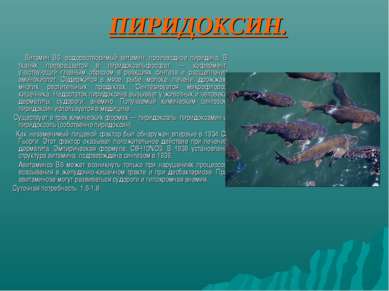 PYRIDOXINE. Vitamin B6, a water-soluble vitamin; pyridine derivative. In tissues it is converted into pyridoxal phosphate, a coenzyme primarily involved in the reactions of synthesis and breakdown of amino acids. Contained in meat, fish, milk, liver, yeast, many plant products. Synthesized by intestinal microflora. Lack of pyridoxine causes dermatitis, convulsions, and anemia in animals and humans. Pyridoxine obtained by chemical synthesis is used in medicine. It exists in three chemical forms - pyridoxal, pyridoxamine and pyridoxole (pyridoxine itself). It was first discovered as an essential nutritional factor in 1934 by S. Gyorgi. This factor had a positive effect in the treatment of dermatitis. Empirical formula: C8H10NO3. The structure of the vitamin was established in 1938 and confirmed by synthesis in 1939. Vitamin B6 deficiency can occur only when absorption processes in the gastrointestinal tract are impaired and due to dysbacteriosis. With vitamin deficiency, convulsions and hypochromic anemia can develop. Daily requirement: 1.6-1.8
PYRIDOXINE. Vitamin B6, a water-soluble vitamin; pyridine derivative. In tissues it is converted into pyridoxal phosphate, a coenzyme primarily involved in the reactions of synthesis and breakdown of amino acids. Contained in meat, fish, milk, liver, yeast, many plant products. Synthesized by intestinal microflora. Lack of pyridoxine causes dermatitis, convulsions, and anemia in animals and humans. Pyridoxine obtained by chemical synthesis is used in medicine. It exists in three chemical forms - pyridoxal, pyridoxamine and pyridoxole (pyridoxine itself). It was first discovered as an essential nutritional factor in 1934 by S. Gyorgi. This factor had a positive effect in the treatment of dermatitis. Empirical formula: C8H10NO3. The structure of the vitamin was established in 1938 and confirmed by synthesis in 1939. Vitamin B6 deficiency can occur only when absorption processes in the gastrointestinal tract are impaired and due to dysbacteriosis. With vitamin deficiency, convulsions and hypochromic anemia can develop. Daily requirement: 1.6-1.8
Slide 6
 A NICOTINIC ACID. vitamin PP - antipellagric factor, niacin, nicotinamide), C6H5NO2, soluble B vitamin, pyridine derivative. As a component of the coenzymes NAD and NADP, it is involved in many oxidative reactions in living cells. Normalizes secretory and motor functions. The first information about the disease, which gastrointestinal tract. With vitamin deficiency PP, pellagra develops and photodermatitis subsequently, called pellagra, dates back to the end of the 16th century. This disease was mainly discovered and therefore actively studied in Italy, Spain and the south of France. In 1771 Frapolli from Milan introduced medical terminology The popular name is “pellagra”, which means “rough skin”. By the end of the 19th century, pellagra was discovered and described in all countries of the world. Soon after the discovery and active study of vitamins, scientists came to the conclusion that pellagra develops due to the lack of a certain factor in food, initially considered as one of the fractions of vitamin B2. Later, the antipellagritic factor was isolated as an independent substance. When people get pellagra, three types of symptoms are observed - the “three Ds”: dermatitis (damage skin), diarrhea (diarrhea) and dementia (mental disorders). Pellagritic dermatitis is characterized by redness of symmetrical areas of the skin, followed by the development of blisters and ulceration. Typically, sunlit areas of the skin undergo changes. Simultaneously with skin lesions, and sometimes without them, intestinal disorders, changes in the mucous membrane of the mouth and tongue, pain in the stomach, and vomiting develop. Neuropsychiatric disorders manifest themselves in the form of hallucinations and psychoses, often with a suicidal tendency. With organic diseases of the gastrointestinal tract (ulcers, cancer, tuberculosis, etc.), the so-called “secondary pellagra” can develop. Its occurrence is due to a violation of the absorption process of the antipellagric vitamin in the gastrointestinal tract. Nicotinic acid was isolated in 1912 by Suzuki from rice bran and in 1913 by K. Funk from yeast. It is a heat-stable and alkali-resistant compound. An empirical and structural formula was established. However, only in 1937 Strong and Woolley obtained from the liver extract used to treat pellagra crystalline substance, which turned out to be nicotinic acid. Main sources: grain, yeast, beef, salmon, herring. Daily requirement: 9-15 mg.
A NICOTINIC ACID. vitamin PP - antipellagric factor, niacin, nicotinamide), C6H5NO2, soluble B vitamin, pyridine derivative. As a component of the coenzymes NAD and NADP, it is involved in many oxidative reactions in living cells. Normalizes secretory and motor functions. The first information about the disease, which gastrointestinal tract. With vitamin deficiency PP, pellagra develops and photodermatitis subsequently, called pellagra, dates back to the end of the 16th century. This disease was mainly discovered and therefore actively studied in Italy, Spain and the south of France. In 1771 Frapolli from Milan introduced medical terminology The popular name is “pellagra”, which means “rough skin”. By the end of the 19th century, pellagra was discovered and described in all countries of the world. Soon after the discovery and active study of vitamins, scientists came to the conclusion that pellagra develops due to the lack of a certain factor in food, initially considered as one of the fractions of vitamin B2. Later, the antipellagritic factor was isolated as an independent substance. When people get pellagra, three types of symptoms are observed - the “three Ds”: dermatitis (damage skin), diarrhea (diarrhea) and dementia (mental disorders). Pellagritic dermatitis is characterized by redness of symmetrical areas of the skin, followed by the development of blisters and ulceration. Typically, sunlit areas of the skin undergo changes. Simultaneously with skin lesions, and sometimes without them, intestinal disorders, changes in the mucous membrane of the mouth and tongue, pain in the stomach, and vomiting develop. Neuropsychiatric disorders manifest themselves in the form of hallucinations and psychoses, often with a suicidal tendency. With organic diseases of the gastrointestinal tract (ulcers, cancer, tuberculosis, etc.), the so-called “secondary pellagra” can develop. Its occurrence is due to a violation of the absorption process of the antipellagric vitamin in the gastrointestinal tract. Nicotinic acid was isolated in 1912 by Suzuki from rice bran and in 1913 by K. Funk from yeast. It is a heat-stable and alkali-resistant compound. An empirical and structural formula was established. However, only in 1937 Strong and Woolley obtained from the liver extract used to treat pellagra crystalline substance, which turned out to be nicotinic acid. Main sources: grain, yeast, beef, salmon, herring. Daily requirement: 9-15 mg.
Slide 7
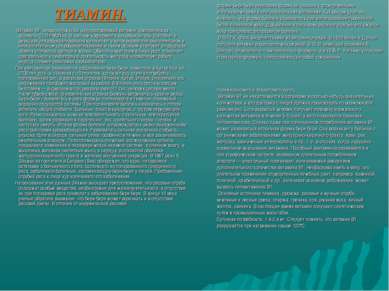 THIAMIN. Vitamin B1, a sulfur-containing water-soluble vitamin. Empirical formula C12H18ON4S. As part of the coenzyme cocarboxylase, it participates in the decarboxylation reactions of keto acids and ketosaccharides during oxidative and non-oxidative decarboxylation, and thus participates in the processes of metabolism of carbohydrates, proteins and fats. Ensures normal growth, increases motor and secretory activity of the stomach, normalizes heart function (thiamine-dependent carboxylase). With vitamin deficiency, the disease beriberi develops, known in China as far back as 2700 BC. e. Starting from the 16th century, when polished rice began to be eaten, this disease became widespread in Asian countries (Japan, China, India, Indonesia). In Japan, it became a real disaster - on average, about 17 thousand people died per year (second place after tuberculosis). In European countries, the disease was extremely rare. Beriberi manifested itself in two forms: polyneuritis and severe lesions of cardio-vascular system. With polyneuritis, the disease began with loss of appetite and general weakness. The patients, as if in shackles, could hardly move their legs. Skin sensitivity (tactile, temperature, pain) sharply decreased, then paralysis of the legs, arms, optic nerve, larynx, and death occurred. The second form of the disease was accompanied by pronounced circulatory disorders. Severe cardiac weakness, shortness of breath, pain in the heart, severe swelling, especially in the liver, developed, and everything ended in death. Pathological microscopic studies of organs showed changes in the peripheral nervous system, in spinal cord, in the muscle fibers of skeletal muscles and the heart, in the mucous membrane of the gastrointestinal tract and glands internal secretion. In 1897, physician H. Eijkman of a hospital in Batavia (Java) discovered that chickens fed hospital table scraps of polished (hulled) rice developed a disease similar to beriberi in humans. Adding rice bran to chicken food cured this disease. Based on these data, Eikman suggested that rice bran contains special substances necessary for life, and the absence of them when polishing rice leads to the disease beriberi. At the end of the 19th century, scientists noticed that beriberi could occur in the absence of a rice diet. In contrast to the endemic rice pyrimidine and thiazole rings. Vitamin B1 does not accumulate in the body in any significant quantities, and its delivery through food should occur as evenly as possible. If an adult receives half the normal amount of vitamin for 5-6 days, he develops signs of hypovitaminosis. However, even with adequate intake of vitamin B1, a secondary form of beriberi can develop. It occurs in patients with organic diseases of the gastrointestinal tract: ulcers, stomach cancer, chronic enterocolitis, etc., i.e. in cases where normal absorption of the vitamin is impaired. A similar vitamin deficiency also develops with atrophic gastritis caused by prolonged alcohol consumption - alcoholic polyneuritis, cured by the introduction of additional amounts of vitamin B1. It must be borne in mind that long-term use of certain therapeutic diets, for example, ulcerative, renal, diabetic, etc., while curing the underlying disease, can cause hypovitaminosis B1. The main sources of thiamine: yeast, rice and flour bran, ground and hazelnuts, asparagus, buckwheat, soybeans, rye flour, egg yolk, pork. Currently, the vitamin is produced synthetically on an industrial scale. Daily requirement: 1.4-2.4 mg. It should be remembered that vitamin B1 is destroyed when heated above 120°C. The non-rice form of beriberi is not associated with specific ethnographic and geographical conditions. As we soon found out, this form of the disease developed when sifted white wheat flour was used. Adding bran or rye flour prevented the development of the disease. In 1912, K. Funk isolated thiamine from rice bran. In 1926, Jansen and Donant obtained the vitamin in crystalline form. In 1931, the German biochemist A. Windaus determined its empirical formula, and in 1935 R. Williams established the structural formula representing the compound
THIAMIN. Vitamin B1, a sulfur-containing water-soluble vitamin. Empirical formula C12H18ON4S. As part of the coenzyme cocarboxylase, it participates in the decarboxylation reactions of keto acids and ketosaccharides during oxidative and non-oxidative decarboxylation, and thus participates in the processes of metabolism of carbohydrates, proteins and fats. Ensures normal growth, increases motor and secretory activity of the stomach, normalizes heart function (thiamine-dependent carboxylase). With vitamin deficiency, the disease beriberi develops, known in China as far back as 2700 BC. e. Starting from the 16th century, when polished rice began to be eaten, this disease became widespread in Asian countries (Japan, China, India, Indonesia). In Japan, it became a real disaster - on average, about 17 thousand people died per year (second place after tuberculosis). In European countries, the disease was extremely rare. Beriberi manifested itself in two forms: polyneuritis and severe lesions of cardio-vascular system. With polyneuritis, the disease began with loss of appetite and general weakness. The patients, as if in shackles, could hardly move their legs. Skin sensitivity (tactile, temperature, pain) sharply decreased, then paralysis of the legs, arms, optic nerve, larynx, and death occurred. The second form of the disease was accompanied by pronounced circulatory disorders. Severe cardiac weakness, shortness of breath, pain in the heart, severe swelling, especially in the liver, developed, and everything ended in death. Pathological microscopic studies of organs showed changes in the peripheral nervous system, in spinal cord, in the muscle fibers of skeletal muscles and the heart, in the mucous membrane of the gastrointestinal tract and glands internal secretion. In 1897, physician H. Eijkman of a hospital in Batavia (Java) discovered that chickens fed hospital table scraps of polished (hulled) rice developed a disease similar to beriberi in humans. Adding rice bran to chicken food cured this disease. Based on these data, Eikman suggested that rice bran contains special substances necessary for life, and the absence of them when polishing rice leads to the disease beriberi. At the end of the 19th century, scientists noticed that beriberi could occur in the absence of a rice diet. In contrast to the endemic rice pyrimidine and thiazole rings. Vitamin B1 does not accumulate in the body in any significant quantities, and its delivery through food should occur as evenly as possible. If an adult receives half the normal amount of vitamin for 5-6 days, he develops signs of hypovitaminosis. However, even with adequate intake of vitamin B1, a secondary form of beriberi can develop. It occurs in patients with organic diseases of the gastrointestinal tract: ulcers, stomach cancer, chronic enterocolitis, etc., i.e. in cases where normal absorption of the vitamin is impaired. A similar vitamin deficiency also develops with atrophic gastritis caused by prolonged alcohol consumption - alcoholic polyneuritis, cured by the introduction of additional amounts of vitamin B1. It must be borne in mind that long-term use of certain therapeutic diets, for example, ulcerative, renal, diabetic, etc., while curing the underlying disease, can cause hypovitaminosis B1. The main sources of thiamine: yeast, rice and flour bran, ground and hazelnuts, asparagus, buckwheat, soybeans, rye flour, egg yolk, pork. Currently, the vitamin is produced synthetically on an industrial scale. Daily requirement: 1.4-2.4 mg. It should be remembered that vitamin B1 is destroyed when heated above 120°C. The non-rice form of beriberi is not associated with specific ethnographic and geographical conditions. As we soon found out, this form of the disease developed when sifted white wheat flour was used. Adding bran or rye flour prevented the development of the disease. In 1912, K. Funk isolated thiamine from rice bran. In 1926, Jansen and Donant obtained the vitamin in crystalline form. In 1931, the German biochemist A. Windaus determined its empirical formula, and in 1935 R. Williams established the structural formula representing the compound
Slide 8
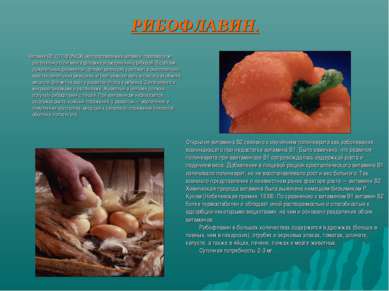 RIBOFLAVIN. Vitamin B2, C17H20N4O6, water-soluble vitamin; a derivative of the plant pigment flavin combined with ribose. As part of respiratory enzymes (flavoproteins), it participates in redox reactions and plays an important role in metabolic processes. Affects the growth and development of the fetus and child. Synthesized by microorganisms and plants. Animals and humans should receive riboflavin from food. With vitamin deficiency, growth retardation and skin lesions are observed; in adults, inflammation and clouding of the lens leading to cataracts and damage to the oral mucosa are observed. The discovery of vitamin B2 is associated with the study of polyneuritis as a disease that occurs due to a lack of vitamin B1. It was noted that the development of polyneuritis with vitamin B1 deficiency was accompanied by growth retardation and weight loss. Adding crystalline vitamin B1 to the diet cured polyneuritis, but did not restore the patient’s height and weight. This is how the idea of a previously unknown growth factor arose - vitamin B2. The chemical nature of the vitamin was clarified by the German biochemist R. Kuhn (Nobel Prize, 1938). Compared to vitamin B1, vitamin B2 is more thermostable and has a different solubility and ability to be adsorbed by certain substances, which is what the separation of both vitamins is based on. Riboflavin is found in large quantities in yeast (more in brewer's than in baker's), bran and cereals, tomatoes, spinach, cabbage, as well as in eggs, liver, kidneys and brains of animals. Daily requirement: 2-3 mg.
RIBOFLAVIN. Vitamin B2, C17H20N4O6, water-soluble vitamin; a derivative of the plant pigment flavin combined with ribose. As part of respiratory enzymes (flavoproteins), it participates in redox reactions and plays an important role in metabolic processes. Affects the growth and development of the fetus and child. Synthesized by microorganisms and plants. Animals and humans should receive riboflavin from food. With vitamin deficiency, growth retardation and skin lesions are observed; in adults, inflammation and clouding of the lens leading to cataracts and damage to the oral mucosa are observed. The discovery of vitamin B2 is associated with the study of polyneuritis as a disease that occurs due to a lack of vitamin B1. It was noted that the development of polyneuritis with vitamin B1 deficiency was accompanied by growth retardation and weight loss. Adding crystalline vitamin B1 to the diet cured polyneuritis, but did not restore the patient’s height and weight. This is how the idea of a previously unknown growth factor arose - vitamin B2. The chemical nature of the vitamin was clarified by the German biochemist R. Kuhn (Nobel Prize, 1938). Compared to vitamin B1, vitamin B2 is more thermostable and has a different solubility and ability to be adsorbed by certain substances, which is what the separation of both vitamins is based on. Riboflavin is found in large quantities in yeast (more in brewer's than in baker's), bran and cereals, tomatoes, spinach, cabbage, as well as in eggs, liver, kidneys and brains of animals. Daily requirement: 2-3 mg.
Slide 9
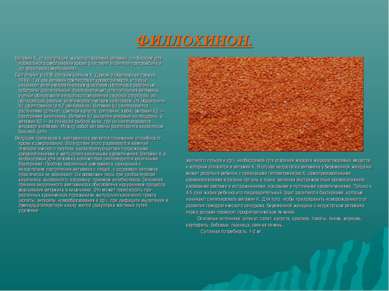 PHYLOQUINONE. Vitamin K, from coagulation, is a fat-soluble vitamin. Necessary for normal blood clotting (participates in the synthesis of prothrombin and other coagulation factors). It was discovered in 1935 by the Danish scientist H. Dam (Nobel Prize, 1943). Since the vitamin prevents bleeding, it is also called an antihemorrhagic factor. Using various substrates (plant, bacterial) to obtain the vitamin, scientists have discovered several compounds of similar structure, but with different antihemorrhagic effects. They were designated K1 (phylloquinone) and K2 (menaquinone). Vitamin K1 is synthesized by plants (spinach, cauliflower, rose hips, pine needles), vitamin K2 - by intestinal bacteria. Vitamin K1 was isolated for the first time from alfalfa, and vitamin K2 was isolated from rotting fishmeal, where it was synthesized by microorganisms. Vitamins differ from each other in the nature of their side chains. The leading symptom of vitamin K deficiency is a decrease in the ability of blood to clot. As a result, the phenomena of hemorrhagic diathesis develop, characterized by subcutaneous hemorrhages and gastrointestinal bleeding. Vitamin K is synthesized in the quantities necessary for humans by intestinal bacteria. Therefore, exogenous vitamin deficiency, associated with a lack of vitamin intake from food, healthy person practically does not occur. It is possible only with intestinal dysbiosis, caused, for example, by taking antibiotics. The main cause of endogenous vitamin deficiency is due to a violation of the absorption process of the vitamin in the intestine. This can occur with various chronic lesions of the gastrointestinal tract (colitis, enteritis, neoplasms, etc.), with a deficiency of excretion in duodenum bile (blockage biliary tract, removal of the gallbladder, etc.), necessary for the absorption of fats and fat-soluble substances, which include vitamin K. If there is a lack of vitamin in a pregnant woman, a child may be born with signs of hypovitaminosis K: spontaneous hemorrhages in the different organs and tissues, including intracranial hemorrhages); bloody vomiting and bowel movements, nosebleeds and umbilical bleeds. Only by the 4-5th day of a child’s life is his digestive tract populated by bacteria that begin to synthesize vitamin K. In order to protect the newborn from development hemorrhagic syndrome, a pregnant woman with vitamin deficiency is given preventive treatment. Main sources: spinach, lettuce, cabbage, nettles, tomatoes, pumpkin, carrots, potatoes, legumes, wheat, pork liver. Daily requirement: 1-2 mg.
PHYLOQUINONE. Vitamin K, from coagulation, is a fat-soluble vitamin. Necessary for normal blood clotting (participates in the synthesis of prothrombin and other coagulation factors). It was discovered in 1935 by the Danish scientist H. Dam (Nobel Prize, 1943). Since the vitamin prevents bleeding, it is also called an antihemorrhagic factor. Using various substrates (plant, bacterial) to obtain the vitamin, scientists have discovered several compounds of similar structure, but with different antihemorrhagic effects. They were designated K1 (phylloquinone) and K2 (menaquinone). Vitamin K1 is synthesized by plants (spinach, cauliflower, rose hips, pine needles), vitamin K2 - by intestinal bacteria. Vitamin K1 was isolated for the first time from alfalfa, and vitamin K2 was isolated from rotting fishmeal, where it was synthesized by microorganisms. Vitamins differ from each other in the nature of their side chains. The leading symptom of vitamin K deficiency is a decrease in the ability of blood to clot. As a result, the phenomena of hemorrhagic diathesis develop, characterized by subcutaneous hemorrhages and gastrointestinal bleeding. Vitamin K is synthesized in the quantities necessary for humans by intestinal bacteria. Therefore, exogenous vitamin deficiency, associated with a lack of vitamin intake from food, healthy person practically does not occur. It is possible only with intestinal dysbiosis, caused, for example, by taking antibiotics. The main cause of endogenous vitamin deficiency is due to a violation of the absorption process of the vitamin in the intestine. This can occur with various chronic lesions of the gastrointestinal tract (colitis, enteritis, neoplasms, etc.), with a deficiency of excretion in duodenum bile (blockage biliary tract, removal of the gallbladder, etc.), necessary for the absorption of fats and fat-soluble substances, which include vitamin K. If there is a lack of vitamin in a pregnant woman, a child may be born with signs of hypovitaminosis K: spontaneous hemorrhages in the different organs and tissues, including intracranial hemorrhages); bloody vomiting and bowel movements, nosebleeds and umbilical bleeds. Only by the 4-5th day of a child’s life is his digestive tract populated by bacteria that begin to synthesize vitamin K. In order to protect the newborn from development hemorrhagic syndrome, a pregnant woman with vitamin deficiency is given preventive treatment. Main sources: spinach, lettuce, cabbage, nettles, tomatoes, pumpkin, carrots, potatoes, legumes, wheat, pork liver. Daily requirement: 1-2 mg.
Slide 10
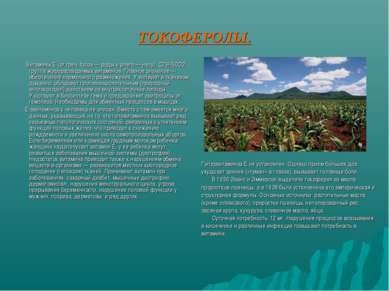 TOCOPHEROLS. Vitamins E (from the Greek tocos - childbirth and phero - I carry), C29H50O2, a group of fat-soluble vitamins. The main importance is to ensure normal reproduction. They participate in tissue respiration and have an antioxidant (natural antioxidant) effect on intracellular lipids. Participate in heme biosynthesis and protects red blood cells from hemolysis. Necessary for metabolic processes in muscles. Vitamin E deficiency has not been described in humans. However, there is a lot of data indicating that hypovitaminosis causes a number of serious pathological conditions associated with suppression of the functions of the gonads, which leads to a decrease in fertility and an increase in the number of spontaneous abortions. If you are pregnant or nursing breast milk If a woman does not receive enough vitamin E, her child may develop diseases of the muscular system (dystrophy). Lack of vitamin also leads to metabolic disorders in the body - local oxygen starvation(hypoxia) of tissues. Take vitamin for diseases: diabetes, muscular dystrophies, dermatomyositis, menstrual irregularities, threat of miscarriage, sexual dysfunction in men, psoriasis, dermatoses and a number of others. Hypervitaminosis E has not been established. However, taking large doses impairs vision (“fog” in the eyes) and causes headaches. In 1936, Evans and Emmerson isolated tocopherol from wheat germ oil, and in 1938 its empirical and structural formulas were established. Main sources: vegetable oils (except olive oil), wheat germ, unpolished rice, oatmeal, corn, butter, eggs. Daily requirement: 12 mg. Disturbances in absorption processes in the intestines and various infections increase the need for the vitamin.
TOCOPHEROLS. Vitamins E (from the Greek tocos - childbirth and phero - I carry), C29H50O2, a group of fat-soluble vitamins. The main importance is to ensure normal reproduction. They participate in tissue respiration and have an antioxidant (natural antioxidant) effect on intracellular lipids. Participate in heme biosynthesis and protects red blood cells from hemolysis. Necessary for metabolic processes in muscles. Vitamin E deficiency has not been described in humans. However, there is a lot of data indicating that hypovitaminosis causes a number of serious pathological conditions associated with suppression of the functions of the gonads, which leads to a decrease in fertility and an increase in the number of spontaneous abortions. If you are pregnant or nursing breast milk If a woman does not receive enough vitamin E, her child may develop diseases of the muscular system (dystrophy). Lack of vitamin also leads to metabolic disorders in the body - local oxygen starvation(hypoxia) of tissues. Take vitamin for diseases: diabetes, muscular dystrophies, dermatomyositis, menstrual irregularities, threat of miscarriage, sexual dysfunction in men, psoriasis, dermatoses and a number of others. Hypervitaminosis E has not been established. However, taking large doses impairs vision (“fog” in the eyes) and causes headaches. In 1936, Evans and Emmerson isolated tocopherol from wheat germ oil, and in 1938 its empirical and structural formulas were established. Main sources: vegetable oils (except olive oil), wheat germ, unpolished rice, oatmeal, corn, butter, eggs. Daily requirement: 12 mg. Disturbances in absorption processes in the intestines and various infections increase the need for the vitamin.
Slide 11
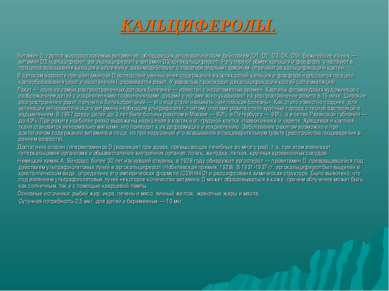 CALCIFEROLS. Vitamin D, a group of fat-soluble vitamins with antirachitic effects (D1, D2, D3, D4, D5). The most important of them are vitamin D2 (calciferol, ergocalciferol) and vitamin D3 (cholecalciferol). They regulate the exchange of calcium and phosphorus: they participate in the process of calcium absorption in the intestines, interact with parathyroid hormone, and are responsible for bone calcification. IN childhood with vitamin D deficiency, due to a decrease in the content of calcium and phosphorus salts in the bones, the process of bone formation (growth and ossification) is disrupted, and rickets develops. In adults, bone decalcification occurs (osteomalacia). Rickets, one of the most common childhood diseases, has been known since time immemorial. Paintings by Flemish artists depicting children with twisted spines, arms and legs clearly indicate the spread of rickets in the 15th century. Rickets became widespread in Great Britain - it was also called the “English disease.” As it became known later, ultraviolet light is needed to activate the anti-rachitic vitamin, so foci of rickets became big cities with dense buildings and smoke. In 1897, among children under 3 years of age, 80% were sick with rickets in Moscow, in St. Petersburg - 96%, and in the villages of the Ryazan province - up to 40%. With rickets, the most pronounced disorders are in the bones of the legs, chest, spine and skull. Cartilage and bone tissue become abnormally soft, which leads to their deformation and curvature. The disease rickets is possible even with sufficient vitamin content in food, but if its absorption in the digestive tract is impaired (digestive disorders in early age). Hypervitaminosis D is quite dangerous (occurs at doses many times higher than therapeutic doses), because this causes hypercalcemia of the body and calcification internal organs: kidneys, stomach, lungs, large blood vessels. The German chemist A. Windaus, who studied sterols for more than 30 years, discovered ergosterol in 1928 - provitamin D, which was converted under the influence of ultraviolet rays into ergocalciferol (Nobel Prize, 1928). In 1931-1937 Ergocalciferol was isolated in crystalline form, its empirical formula (C28H44O) was determined and its chemical structure was deciphered. It was found that under the influence of ultraviolet rays, a certain amount of vitamin D can be formed in the skin, and irradiation can be either solar or using a quartz lamp. Main sources: fish fat, caviar, liver and meat, egg yolk, animal fats and oils. The daily requirement is 2.5 mcg, for children and pregnant women - 10 mcg.
CALCIFEROLS. Vitamin D, a group of fat-soluble vitamins with antirachitic effects (D1, D2, D3, D4, D5). The most important of them are vitamin D2 (calciferol, ergocalciferol) and vitamin D3 (cholecalciferol). They regulate the exchange of calcium and phosphorus: they participate in the process of calcium absorption in the intestines, interact with parathyroid hormone, and are responsible for bone calcification. IN childhood with vitamin D deficiency, due to a decrease in the content of calcium and phosphorus salts in the bones, the process of bone formation (growth and ossification) is disrupted, and rickets develops. In adults, bone decalcification occurs (osteomalacia). Rickets, one of the most common childhood diseases, has been known since time immemorial. Paintings by Flemish artists depicting children with twisted spines, arms and legs clearly indicate the spread of rickets in the 15th century. Rickets became widespread in Great Britain - it was also called the “English disease.” As it became known later, ultraviolet light is needed to activate the anti-rachitic vitamin, so foci of rickets became big cities with dense buildings and smoke. In 1897, among children under 3 years of age, 80% were sick with rickets in Moscow, in St. Petersburg - 96%, and in the villages of the Ryazan province - up to 40%. With rickets, the most pronounced disorders are in the bones of the legs, chest, spine and skull. Cartilage and bone tissue become abnormally soft, which leads to their deformation and curvature. The disease rickets is possible even with sufficient vitamin content in food, but if its absorption in the digestive tract is impaired (digestive disorders in early age). Hypervitaminosis D is quite dangerous (occurs at doses many times higher than therapeutic doses), because this causes hypercalcemia of the body and calcification internal organs: kidneys, stomach, lungs, large blood vessels. The German chemist A. Windaus, who studied sterols for more than 30 years, discovered ergosterol in 1928 - provitamin D, which was converted under the influence of ultraviolet rays into ergocalciferol (Nobel Prize, 1928). In 1931-1937 Ergocalciferol was isolated in crystalline form, its empirical formula (C28H44O) was determined and its chemical structure was deciphered. It was found that under the influence of ultraviolet rays, a certain amount of vitamin D can be formed in the skin, and irradiation can be either solar or using a quartz lamp. Main sources: fish fat, caviar, liver and meat, egg yolk, animal fats and oils. The daily requirement is 2.5 mcg, for children and pregnant women - 10 mcg.
Slide 12
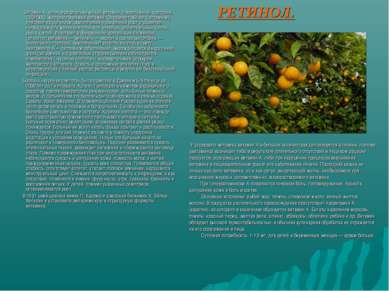 RETINOL. Vitamin A, antixerophthalmic vitamin, provitamins: carotenes, C20H30O, fat-soluble vitamin. It has a general (systemic) effect on the body, ensuring normal growth and development. Essential for the functioning of nerve and epithelial cells and bone growth. Participates in the formation of visual pigments (vitamin aldehyde - retinal - is part of rhodopsin - visual purple), ensures adaptation of the eyes to light. Vitamin A deficiency is a systemic disease that results in impaired vision. At various stages of the disease, hemeralopia (“night blindness”), xerophthalmia (atrophy of the glandular apparatus, dryness and keratinization of the eye epithelium) and keratomolation (purulent decay of the cornea as a result of bacterial infection). The disease “night blindness” was known in Ancient Egypt 1000 years before Hippocrates. By the way, Hippocrates recommended eating bovine liver with honey as a radical remedy against hemeralopia. This disease was later discovered in different countries Europe, Asia, America. IN pre-revolutionary Russia night blindness was common in prisons and almshouses. It usually affected the poorest peasantry and soldiers. Night blindness is primarily a disorder of the twilight rod apparatus of the retina. Patients see normally during the day, but at dusk, visual acuity decreases sharply. Patients cannot read, letters jump and blur. The transition from light to darkness is very difficult for them (adaptation to lighting conditions is impaired). At night, these patients cannot distinguish anything and are completely helpless. Later, dryness of the epithelial tissues develops, suppuration occurs and the cornea of the eye is damaged. In addition to eye damage, vitamin deficiency causes dry and flaky skin, brittle hair and nails, premature graying, and dryness of all mucous membranes. General weakness appears, there is no appetite, libido fades, and menstrual cycle. Resistance to infections decreases, and as a result, barley, boils, acne, tracheitis, bronchitis and pneumonia appear. In children, in addition to specified symptoms, growth stops. In 1931, the Swiss chemist P. Karrer and the Swedish biochemist H. Euler-Helpin established empirical and structural formula vitamin A. In a healthy person, vitamin A is deposited in large quantities in the liver, so vitamin deficiency occurs either as a result of a long-term absence of foods containing vitamin A in the diet, or when the absorption of the vitamin in the digestive tract is disrupted or liver disease. The latter is important not only as a vitamin depot, but also as an organ that secretes bile, necessary for the absorption of fats and, accordingly, fat-soluble vitamins. With hypervitaminosis A appear headache, dizziness, nausea, peeling skin and bone pain. Main sources: fish oil, liver, butter, egg yolk, milk. In products plant origin provitamin A (carotene) is present, from which vitamin A is formed in the intestines. Carrots, tomatoes, red peppers, yellow turnips, spinach, apricots, sea buckthorn, rowan berries, etc. are rich in carotene. The vitamin has high heat stability, and ordinary cooking does not affect it content in food. Daily requirement: 1-1.5 mg, for children and pregnant women - twice as much.
RETINOL. Vitamin A, antixerophthalmic vitamin, provitamins: carotenes, C20H30O, fat-soluble vitamin. It has a general (systemic) effect on the body, ensuring normal growth and development. Essential for the functioning of nerve and epithelial cells and bone growth. Participates in the formation of visual pigments (vitamin aldehyde - retinal - is part of rhodopsin - visual purple), ensures adaptation of the eyes to light. Vitamin A deficiency is a systemic disease that results in impaired vision. At various stages of the disease, hemeralopia (“night blindness”), xerophthalmia (atrophy of the glandular apparatus, dryness and keratinization of the eye epithelium) and keratomolation (purulent decay of the cornea as a result of bacterial infection). The disease “night blindness” was known in Ancient Egypt 1000 years before Hippocrates. By the way, Hippocrates recommended eating bovine liver with honey as a radical remedy against hemeralopia. This disease was later discovered in different countries Europe, Asia, America. IN pre-revolutionary Russia night blindness was common in prisons and almshouses. It usually affected the poorest peasantry and soldiers. Night blindness is primarily a disorder of the twilight rod apparatus of the retina. Patients see normally during the day, but at dusk, visual acuity decreases sharply. Patients cannot read, letters jump and blur. The transition from light to darkness is very difficult for them (adaptation to lighting conditions is impaired). At night, these patients cannot distinguish anything and are completely helpless. Later, dryness of the epithelial tissues develops, suppuration occurs and the cornea of the eye is damaged. In addition to eye damage, vitamin deficiency causes dry and flaky skin, brittle hair and nails, premature graying, and dryness of all mucous membranes. General weakness appears, there is no appetite, libido fades, and menstrual cycle. Resistance to infections decreases, and as a result, barley, boils, acne, tracheitis, bronchitis and pneumonia appear. In children, in addition to specified symptoms, growth stops. In 1931, the Swiss chemist P. Karrer and the Swedish biochemist H. Euler-Helpin established empirical and structural formula vitamin A. In a healthy person, vitamin A is deposited in large quantities in the liver, so vitamin deficiency occurs either as a result of a long-term absence of foods containing vitamin A in the diet, or when the absorption of the vitamin in the digestive tract is disrupted or liver disease. The latter is important not only as a vitamin depot, but also as an organ that secretes bile, necessary for the absorption of fats and, accordingly, fat-soluble vitamins. With hypervitaminosis A appear headache, dizziness, nausea, peeling skin and bone pain. Main sources: fish oil, liver, butter, egg yolk, milk. In products plant origin provitamin A (carotene) is present, from which vitamin A is formed in the intestines. Carrots, tomatoes, red peppers, yellow turnips, spinach, apricots, sea buckthorn, rowan berries, etc. are rich in carotene. The vitamin has high heat stability, and ordinary cooking does not affect it content in food. Daily requirement: 1-1.5 mg, for children and pregnant women - twice as much.
Slide 13
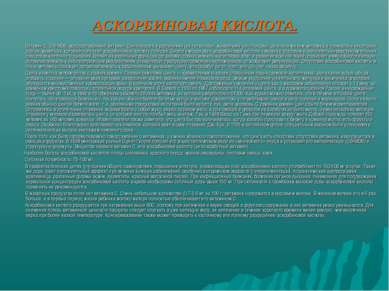 ASCORBIC ACID. Vitamin C, C6H8O6, water-soluble vitamin. It is synthesized by plants (from galactose), animals (from glucose), with the exception of humans and primates and some other animals that receive ascorbic acid from food. The biological role of ascorbic acid is associated with participation in the redox processes of cellular respiration. Affects various functions body: capillary permeability, growth and development bone tissue , increases immunobiological resistance to adverse effects, stimulates the production of adrenal hormones, and promotes regeneration. The absence of ascorbic acid in human food reduces resistance to diseases, causes scurvy, or scurvy (from Old Dutch or Old Danish “mouth ulcer”). Scurvy has been known to mankind since ancient times. The first symptoms of scurvy are bleeding gums (increased capillary permeability), tooth loss, general weakness, later - swelling of all joints, bone destruction, the occurrence of heart defects, a sharp deterioration in the functioning of the stomach and intestines, in which multiple bleeding ulcers form. Ultimately death occurs. Reliable information about scurvy as a mass disease dates back to the 13th century, to the times of the Crusades with long siege of fortresses. In Europe, from 1556 to 1857, 114 scurvy epidemics were observed, and in pre-revolutionary Russia, in lean years, more than 30. Thus, in 1849, 260,444 people fell ill in 16 provinces, of whom almost 61,000 died. As a curiosity, it can be noted that in the 18th century in Russia scurvy was considered a “noble disease”, since it usually affected rich merchants and the highest nobility who consumed vegetables in the form of pickles and marinades. People of low rank usually suffered little from scurvy, since their main foods were cabbage, onions, turnips, and carrots. Since ancient times, scurvy has been the scourge of sailors. When going on long voyages, sailors took with them flour, grain, dried meat, but there was no room on the ships for vegetables and fruits. After several months of sailing, the sailors developed scurvy, which sometimes killed the entire crew. So, in 1498, Vasco da Gama, while sailing around the Cape of Good Hope, lost 150 people out of a 160-person crew. Sailors also noticed that scurvy was quickly cured when the ship came ashore and the crew could eat fruits and vegetables. The juice of lemons that J. Cook took on his voyage had a particularly beneficial effect. In 1795, a special law established the systematic distribution of lemon juice to crews by a special law. After the idea of vitamins was formulated, scientists assumed that scurvy was a consequence of the lack of vitamins found in vegetables and fruits. In 1928, the Hungarian scientist Szent-Georgi obtained it in crystalline form from “Hungarian” pepper and established its empirical (C6H8O6) and structural formula. The substance was called vitamin C, or ascorbic acid (antiscorbutic vitamin). The richest fruits in ascorbic acid are rose hips, red peppers, black currants, leafy vegetables, and pine needles. Daily requirement: 75-100 mg. For preventive purposes (improving general well-being, increasing appetite, normalizing sleep), ascorbic acid is consumed at a rate of 150-200 mg per day. The same doses give a positive effect in the treatment of skin diseases, especially in old age (hyperpigmentation, psoriatic erythroderma, urticaria, various shapes eczema, dermatitis, lichen planus). At infectious diseases, respiratory diseases, pneumonia, daily doses above 150 mg are required to maintain normal concentrations of ascorbic acid in the blood. If you are prone to thrombosis, high doses of ascorbic acid are not recommended. There is almost no vitamin C in animal products. A very small amount (0.7-2.6 mg per 100 g) of the vitamin is found in cow's milk. There is 5 times more of it in human milk, and in the first period of a child’s life, mother’s milk completely provides him with vitamin C. Ascorbic acid is destroyed when heated above 60C, therefore, when boiling and cooking vegetables and fruits, the vitamin content in them sharply decreases. To reduce the loss of vitamin value, products should be immersed in already boiling water; boiling them for a short time is less harmful than slow cooking at a lower temperature. Canning can also lead to partial or complete destruction ascorbic acid.
ASCORBIC ACID. Vitamin C, C6H8O6, water-soluble vitamin. It is synthesized by plants (from galactose), animals (from glucose), with the exception of humans and primates and some other animals that receive ascorbic acid from food. The biological role of ascorbic acid is associated with participation in the redox processes of cellular respiration. Affects various functions body: capillary permeability, growth and development bone tissue , increases immunobiological resistance to adverse effects, stimulates the production of adrenal hormones, and promotes regeneration. The absence of ascorbic acid in human food reduces resistance to diseases, causes scurvy, or scurvy (from Old Dutch or Old Danish “mouth ulcer”). Scurvy has been known to mankind since ancient times. The first symptoms of scurvy are bleeding gums (increased capillary permeability), tooth loss, general weakness, later - swelling of all joints, bone destruction, the occurrence of heart defects, a sharp deterioration in the functioning of the stomach and intestines, in which multiple bleeding ulcers form. Ultimately death occurs. Reliable information about scurvy as a mass disease dates back to the 13th century, to the times of the Crusades with long siege of fortresses. In Europe, from 1556 to 1857, 114 scurvy epidemics were observed, and in pre-revolutionary Russia, in lean years, more than 30. Thus, in 1849, 260,444 people fell ill in 16 provinces, of whom almost 61,000 died. As a curiosity, it can be noted that in the 18th century in Russia scurvy was considered a “noble disease”, since it usually affected rich merchants and the highest nobility who consumed vegetables in the form of pickles and marinades. People of low rank usually suffered little from scurvy, since their main foods were cabbage, onions, turnips, and carrots. Since ancient times, scurvy has been the scourge of sailors. When going on long voyages, sailors took with them flour, grain, dried meat, but there was no room on the ships for vegetables and fruits. After several months of sailing, the sailors developed scurvy, which sometimes killed the entire crew. So, in 1498, Vasco da Gama, while sailing around the Cape of Good Hope, lost 150 people out of a 160-person crew. Sailors also noticed that scurvy was quickly cured when the ship came ashore and the crew could eat fruits and vegetables. The juice of lemons that J. Cook took on his voyage had a particularly beneficial effect. In 1795, a special law established the systematic distribution of lemon juice to crews by a special law. After the idea of vitamins was formulated, scientists assumed that scurvy was a consequence of the lack of vitamins found in vegetables and fruits. In 1928, the Hungarian scientist Szent-Georgi obtained it in crystalline form from “Hungarian” pepper and established its empirical (C6H8O6) and structural formula. The substance was called vitamin C, or ascorbic acid (antiscorbutic vitamin). The richest fruits in ascorbic acid are rose hips, red peppers, black currants, leafy vegetables, and pine needles. Daily requirement: 75-100 mg. For preventive purposes (improving general well-being, increasing appetite, normalizing sleep), ascorbic acid is consumed at a rate of 150-200 mg per day. The same doses give a positive effect in the treatment of skin diseases, especially in old age (hyperpigmentation, psoriatic erythroderma, urticaria, various shapes eczema, dermatitis, lichen planus). At infectious diseases, respiratory diseases, pneumonia, daily doses above 150 mg are required to maintain normal concentrations of ascorbic acid in the blood. If you are prone to thrombosis, high doses of ascorbic acid are not recommended. There is almost no vitamin C in animal products. A very small amount (0.7-2.6 mg per 100 g) of the vitamin is found in cow's milk. There is 5 times more of it in human milk, and in the first period of a child’s life, mother’s milk completely provides him with vitamin C. Ascorbic acid is destroyed when heated above 60C, therefore, when boiling and cooking vegetables and fruits, the vitamin content in them sharply decreases. To reduce the loss of vitamin value, products should be immersed in already boiling water; boiling them for a short time is less harmful than slow cooking at a lower temperature. Canning can also lead to partial or complete destruction ascorbic acid.
Slide 14
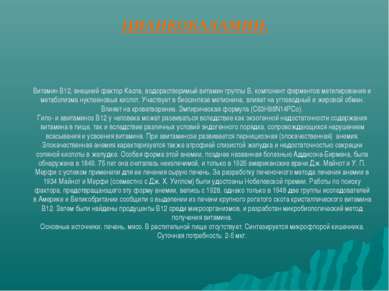 CYANCOBALAMIN. Vitamin B12, external factor Kasla, a water-soluble B vitamin, is a component of methylation and nucleic acid metabolism enzymes. Participates in the biosynthesis of methionine, affects carbohydrate and fat metabolism. Affects hematopoiesis. Empirical formula (С63Н88N14ПСo). Hypo- and avitaminosis B12 in humans can develop due to both exogenous deficiency of the vitamin in food and due to various conditions endogenous order, accompanied by impaired absorption and assimilation of the vitamin. With vitamin deficiency, pernicious (malignant) anemia develops. Pernicious anemia also characterized by atrophy of the gastric mucosa and insufficiency of secretion of hydrochloric acid in the stomach. A special form of this anemia, later called Addison-Bearman disease, was discovered in 1849. For 75 years it was considered incurable, and only in 1926 the American doctors J. Minot and W. P. Murphy successfully used raw liver to treat it. For the development of a hepatic method of treating anemia in 1934, Minot and Murphy (together with J. H. Whipple) were awarded Nobel Prize. Work to find a factor that prevents this form of anemia has been carried out since 1928, but it was only in 1948 that two groups of researchers in America and Great Britain reported the isolation of crystalline vitamin B12 from the liver of cattle. Then B12 producers were found among microorganisms, and a microbiological method for obtaining the vitamin was developed. Main sources: liver, meat. Absent in plant foods. Synthesized by intestinal microflora. Daily requirement: 2-5 mcg.
CYANCOBALAMIN. Vitamin B12, external factor Kasla, a water-soluble B vitamin, is a component of methylation and nucleic acid metabolism enzymes. Participates in the biosynthesis of methionine, affects carbohydrate and fat metabolism. Affects hematopoiesis. Empirical formula (С63Н88N14ПСo). Hypo- and avitaminosis B12 in humans can develop due to both exogenous deficiency of the vitamin in food and due to various conditions endogenous order, accompanied by impaired absorption and assimilation of the vitamin. With vitamin deficiency, pernicious (malignant) anemia develops. Pernicious anemia also characterized by atrophy of the gastric mucosa and insufficiency of secretion of hydrochloric acid in the stomach. A special form of this anemia, later called Addison-Bearman disease, was discovered in 1849. For 75 years it was considered incurable, and only in 1926 the American doctors J. Minot and W. P. Murphy successfully used raw liver to treat it. For the development of a hepatic method of treating anemia in 1934, Minot and Murphy (together with J. H. Whipple) were awarded Nobel Prize. Work to find a factor that prevents this form of anemia has been carried out since 1928, but it was only in 1948 that two groups of researchers in America and Great Britain reported the isolation of crystalline vitamin B12 from the liver of cattle. Then B12 producers were found among microorganisms, and a microbiological method for obtaining the vitamin was developed. Main sources: liver, meat. Absent in plant foods. Synthesized by intestinal microflora. Daily requirement: 2-5 mcg.
Slide 15
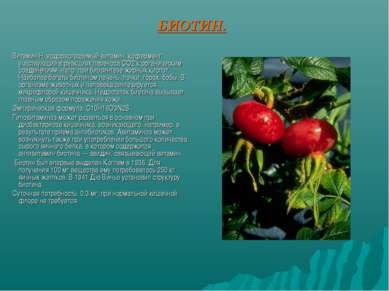 BIOTIN. Vitamin H, a water-soluble vitamin; coenzyme involved in CO2 transfer reactions to organic compounds, eg. in the biosynthesis of fatty acids. The richest foods in biotin are liver, kidneys, peas, and beans. In the body of animals and humans it is synthesized by intestinal microflora. Biotin deficiency mainly causes skin lesions. Empirical formula: C10H16O3N2S. Hypovitaminosis can develop mainly due to intestinal dysbiosis, which occurs, for example, as a result of taking antibiotics. Vitamin deficiency can also occur when consuming large quantity raw egg white, which contains the antivitamin biotin - avidin, a binding vitamin. Biotin was first isolated by Cogl in 1935. To obtain 100 mg of the substance, he needed 250 kg of egg yolks. In 1941 Du Vigneault established the structure of biotin. Daily requirement: 0.3 mg; with normal intestinal flora it is not required.
BIOTIN. Vitamin H, a water-soluble vitamin; coenzyme involved in CO2 transfer reactions to organic compounds, eg. in the biosynthesis of fatty acids. The richest foods in biotin are liver, kidneys, peas, and beans. In the body of animals and humans it is synthesized by intestinal microflora. Biotin deficiency mainly causes skin lesions. Empirical formula: C10H16O3N2S. Hypovitaminosis can develop mainly due to intestinal dysbiosis, which occurs, for example, as a result of taking antibiotics. Vitamin deficiency can also occur when consuming large quantity raw egg white, which contains the antivitamin biotin - avidin, a binding vitamin. Biotin was first isolated by Cogl in 1935. To obtain 100 mg of the substance, he needed 250 kg of egg yolks. In 1941 Du Vigneault established the structure of biotin. Daily requirement: 0.3 mg; with normal intestinal flora it is not required.
Slide 16
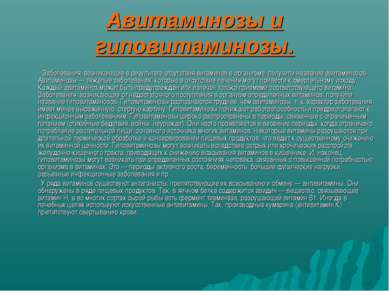 Avitaminosis and hypovitaminosis. Diseases that arise as a result of a lack of vitamins in the body are called vitamin deficiencies. Vitamin deficiencies are serious diseases that, if left untreated, can lead to death. Each vitamin deficiency can be prevented or cured only by taking the appropriate vitamin. Diseases that arise from insufficient intake of certain vitamins into the body are called hypovitaminosis. Hypovitaminosis is more difficult to recognize than avitaminosis, because the nature of the disease has a less pronounced, blurred picture. Hypovitaminosis reduces performance and predisposes to infectious diseases. Hypovitaminosis is widespread during periods associated with limited nutrition (natural disasters, wars, crop failures). They often appear in the spring, when the consumption of plant foods, the main source of many vitamins, is limited. Some vitamins are destroyed during prolonged heat treatment and canning. food products, which leads to a significant decrease in their vitamin value. Hypovitaminosis can occur as a result of acute or chronic disorders of the gastrointestinal tract, leading to decreased absorption of vitamins in the intestine. And finally, hypovitaminosis can occur in certain human conditions associated with the body’s increased need for vitamins. These are periods of active growth, pregnancy, large physical exercise, serious infectious diseases, etc. A number of vitamins have antagonists that prevent their absorption and metabolism - antivitamins. They are found in a number of foods. So, in egg white contains avidin, a substance that binds vitamin H, and many varieties of raw fish contain the enzyme thiaminase, which destroys vitamin B1. Sometimes in medicinal purposes use artificial antivitamins. Thus, coumarin derivatives (antivitamin K) prevent blood clotting.
Avitaminosis and hypovitaminosis. Diseases that arise as a result of a lack of vitamins in the body are called vitamin deficiencies. Vitamin deficiencies are serious diseases that, if left untreated, can lead to death. Each vitamin deficiency can be prevented or cured only by taking the appropriate vitamin. Diseases that arise from insufficient intake of certain vitamins into the body are called hypovitaminosis. Hypovitaminosis is more difficult to recognize than avitaminosis, because the nature of the disease has a less pronounced, blurred picture. Hypovitaminosis reduces performance and predisposes to infectious diseases. Hypovitaminosis is widespread during periods associated with limited nutrition (natural disasters, wars, crop failures). They often appear in the spring, when the consumption of plant foods, the main source of many vitamins, is limited. Some vitamins are destroyed during prolonged heat treatment and canning. food products, which leads to a significant decrease in their vitamin value. Hypovitaminosis can occur as a result of acute or chronic disorders of the gastrointestinal tract, leading to decreased absorption of vitamins in the intestine. And finally, hypovitaminosis can occur in certain human conditions associated with the body’s increased need for vitamins. These are periods of active growth, pregnancy, large physical exercise, serious infectious diseases, etc. A number of vitamins have antagonists that prevent their absorption and metabolism - antivitamins. They are found in a number of foods. So, in egg white contains avidin, a substance that binds vitamin H, and many varieties of raw fish contain the enzyme thiaminase, which destroys vitamin B1. Sometimes in medicinal purposes use artificial antivitamins. Thus, coumarin derivatives (antivitamin K) prevent blood clotting.
Slide 17
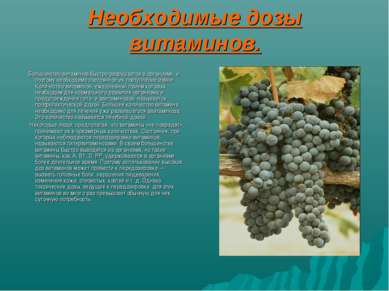 Required doses of vitamins. Most vitamins are quickly destroyed in the body, and therefore their constant supply from the outside is necessary. The amount of vitamins, the daily intake of which is necessary for the normal development of the body and the prevention of hypo- and avitaminosis, is called a prophylactic dose. A larger amount of vitamin is necessary to treat already developed vitamin deficiency. This amount is called the therapeutic dose. Some people, assuming that vitamins “will do no harm,” take them in excessive quantities. Conditions in which overdoses of vitamins are observed are called hypervitaminosis. Most vitamins are quickly eliminated from the body, but vitamins such as A, B1, D, PP are retained in the body for a longer time. Therefore, the use of high doses of vitamins can lead to an overdose - causing headaches, digestive disorders, changes in the skin, mucous membranes, bones, etc. However, toxic doses leading to an overdose for these vitamins are many times higher than their usual daily requirement.
Required doses of vitamins. Most vitamins are quickly destroyed in the body, and therefore their constant supply from the outside is necessary. The amount of vitamins, the daily intake of which is necessary for the normal development of the body and the prevention of hypo- and avitaminosis, is called a prophylactic dose. A larger amount of vitamin is necessary to treat already developed vitamin deficiency. This amount is called the therapeutic dose. Some people, assuming that vitamins “will do no harm,” take them in excessive quantities. Conditions in which overdoses of vitamins are observed are called hypervitaminosis. Most vitamins are quickly eliminated from the body, but vitamins such as A, B1, D, PP are retained in the body for a longer time. Therefore, the use of high doses of vitamins can lead to an overdose - causing headaches, digestive disorders, changes in the skin, mucous membranes, bones, etc. However, toxic doses leading to an overdose for these vitamins are many times higher than their usual daily requirement.
Presentation on the topic:Vitamins Nikolina Maria, 8th “RO” grade
The term Vitamins (from the Latin Vita - life) - special organic matter, which, although not a source of energy or a building material for the body, are nevertheless necessary (in minimal quantities) for its normal functioning (and even for its very existence). They participate in metabolism, are biological accelerators of chemical reactions occurring in the cell, increase resistance to infectious diseases, reduce bad influence various occupational hazards, etc. Vitamins are designated by letters of the Latin alphabet (A, B, C, D, etc.); in addition, they have special names. All vitamins are divided into 2 groups: water-soluble - vitamins C, P and group B), and fat-soluble (vitamins A, E, D, K).
History of the discovery of vitamins In the second half of the 19th century, it was believed that the nutritional value Products are determined by their content of proteins, fats, carbohydrates, mineral salts and water. Meanwhile, over the centuries, humanity has accumulated considerable experience in long sea voyages, when, with sufficient food supplies, people died from scurvy. Why? This question was not answered until in 1880, the Russian scientist Nikolai Lunin, who was studying the role of minerals in nutrition, noticed that mice that consumed artificial food made up of all known parts of milk (casein, fat, sugar and salts) ), withered away and died. And the mice that received natural milk were cheerful and healthy. “It follows from this that milk... contains other substances that are essential for nutrition,” the scientist concluded. Another 16 years later, they found the cause of the beriberi disease, common among residents of Japan and Indonesia, who ate mainly refined rice. Doctor Aikman, who worked in a prison hospital on the island of Java, was helped by... chickens wandering around the yard. They were fed refined grains and the birds suffered from a beriberi-like disease. As soon as you noticed it on unpeeled rice, the disease went away. The first to isolate the vitamin in crystalline form was the Polish scientist Casimir Funk in 1911. A year later, he also came up with the name - from the Latin “vita” - “life”.
Two words about biological role vitamins At the cellular level, they participate in the construction and functioning of biomembranes. Vitamins A, E, K also determine many properties, such as permeability, enzyme activity, etc. On the other hand, it is involved in the construction of enzyme regulation. For most vitamins, their coenzyme role has been proven - their participation in the construction of coenzymes, and not some kind of inert participation, but in the form of an active component. Without vitamin coenzyme, most enzymes - catalysts of all metabolic processes in the body, regulators of all aspects of life - do not work. The most famous: vitamin B1 coenzyme is a cocarboxylase used in cardiology. Vitamins B2, B6, niacin, folic acid, vitamin C, vitamin K is an interesting fat-soluble vitamin. Thus, without vitamins, the formation of biomembranes and coenzymes is impossible. Therefore, with a lack of vitamins (hypovitaminosis and avitaminosis), real threat for human life. First of all, this is the immune response, hematopoiesis, reproductive function, functioning of the heart muscle, skeletal, nervous system, brain, problems of growth, development, wound healing. The gastrointestinal tract, kidneys, liver - almost all organs and tissues need vitamins; they are irreplaceable nutritional factors.
Who needs vitamins? A balanced diet is the most important condition for maintaining health, normal growth and development of the human body. According to the latest data from the World Health Organization (WHO), only 15% of a person’s health depends on the organization medical service, the same amount - from genetic characteristics, and 70% - from lifestyle and nutrition. Nutritional adequacy is determined not only energy value food, a balanced diet of proteins, fats and carbohydrates, but also a supply of vitamins, microelements and minerals. Calculations show that corresponding to average energy consumption modern man The diet, even a balanced and varied one, is deficient in most vitamins by 20-30%. The results of population studies conducted by the Institute of Nutrition of the Russian Academy of Medical Sciences indicate a very alarming situation in last years in Russia. There is extremely insufficient consumption and an increasingly growing deficiency of vitamins (A, group B, C, E) and a number of microelements (iron, zinc, iodine) in a significant part of the population. Thus, deficiency of B vitamins is detected in 30-40%, beta-carotene - in more than 40%, vitamin C - in 70-90% of subjects. At the same time, vitamin deficiency is not seasonal and is found not only in winter and spring, but also in the summer and autumn. General situation can be considered as a massive year-round polyhypovitaminosis.
Classification of vitamins Vitamins are divided into two groups: water-soluble and fat-soluble. This division exists not only because some of them dissolve in water, while others do not, but also because water-soluble ones cannot accumulate in the body in reserve, but fat-soluble ones (dissolving in body fats) can. Fat-soluble vitamins dissolve in gasoline, ether and fats. In contrast, water-soluble vitamins do not dissolve in fats, but are soluble in water and alcohol. Along with vitamins, a group of vitamin-like compounds is known. These include choline, inositol, orotic, lipoic and para-aminobenzoic acids, carnitine, bioflavonoids (rutin, quercetin, tea catechins) and a number of other compounds that have certain properties of vitamins. Vitamin-like compounds in the classical sense are not vitamins, since they can be synthesized in the body from their precursors, so a deficiency of each of them does not lead to the picture of classical vitamin deficiency. But, nevertheless, their synthesis in the body is limited, so it is more correct to enter them into the body not only with food, but also with vitamin preparations.
Table 1. Modern classification of vitamins
Vitamins Vitamin A is a whole group of compounds. The most common in nature are: retinol (vitamin A1), dehydroretinol (vitamin A2), retinoic acid; provitamins – carotenes – are present in plants. Increases tone, restores the epidermis, nourishes, softens, protects, regenerates and renews the skin. Exfoliates dead cells, smoothes wrinkles, heals, relieves inflammation and irritation, gives elasticity to hair and skin, and prevents water loss. Vitamin C (ascorbic acid) is one of the essential vitamins. It is an antioxidant, increases vascular elasticity, stimulates collagen synthesis, cellular respiration, and regenerates the skin. Activates blood microcirculation, whitens the skin, reduces pigmentation. Moisturizes, nourishes, protects against harmful influences and prevents aging. Strengthens tissues, gives elasticity to hair and skin. Has anti-inflammatory and anti-allergic effects. Increases immunity. Vitamin E (tocopherols) is an antioxidant that prevents the formation of free radicals. An excellent assistant in the fight against skin aging, retains natural moisture, nourishes, and protects from UV radiation. Protects hair from aging, protects from external influences. Nourishes and strengthens hair follicles, improves metabolism in the hair roots. B vitamins are a whole group of substances. They accelerate the regeneration and epithelization of the skin, promote its hydration and elasticity, participate in fat metabolism, and fight seborrhea.
Vitamin B1 (thiamine) - heals wounds, regenerates skin and hair. Used to treat acne, dermatitis, age spots, seborrhea. Vitamin B2 (riboflavin) - stimulates energy production in cells. Improves the condition of skin, hair, nails, strengthens them. Growth vitamin. Prevents hair loss. Treats acne, seborrhea, cracks and mouth ulcers. Rejuvenates the skin. Vitamin B6 (pyridoxine) - stimulates metabolism, prevents cracks in the corners of the mouth, hair loss, brittle nails, strengthens the epidermis and hair roots. Treats seborrhea, acne and dermatitis. Vitamin B9 or Bc (folic acid) – supports healthy hair growth, prevents baldness, acne and other inflammations. Vitamin B0 or H1 (para-aminobenzoic acid) – maintains natural hair color and beautiful colour skin, protects against sunburn. Vitamin B5 (D-panthenol, pantothenic acid) – participates in the biosynthesis and transformation of fatty acids, moisturizes, soothes, relieves irritation and itching, has a strong rejuvenating and smoothing effect, restores and protects the skin, relieves inflammation. Restores damaged hair structure, smoothes its surface, nourishes and strengthens roots. Absorbed by hair better than other vitamins.
Vitamin H (biotin) – prevents swelling, restores skin color, hair shine and nail strength. Regulates the activity of the sebaceous glands. Vitamin P (rutin) - helps with acne, facial redness, hair loss. Reduces the permeability and fragility of capillaries, has an anti-inflammatory effect. Vitamin PP (B3) – common name nicotinic acid and nicotinamide, heals wounds and burns, eliminates pimples, blackheads and dry skin, participates in cellular respiration reactions, normalizes the condition of hair follicles, accelerates hair growth, stimulates metabolic processes in their roots, prevents graying and hair loss. Vitamin F is not a vitamin in the strict sense. A set of essential polyunsaturated fatty acids (linoleic, linolenic, arachidonic), an important component cell membranes. Participates in oxygen and fat metabolism, eliminates inflammation, restores cells, prevents roughness, dryness, flaking, rash, dandruff formation, fragility and hair loss. Removes dead cells, protects the skin from harmful influences and household chemicals, regenerates the skin's hydrolipidic barrier. Strengthens hair, increases the rigidity of the hair shaft, restores its damaged structure.
Vitamins in food The main source of vitamins for humans is food (see Table 2). The content of vitamins in the diet may vary and depends on various reasons: on the variety and type of products, methods and periods of their storage, the nature of the technological processing of food, the choice of dishes and eating habits. The composition of food plays an important role. When carbohydrates predominate in the diet, the body requires more vitamins B1, B2 and C. If there is a lack of protein in the diet, the absorption of vitamin B2, nicotinic acid, vitamin C is reduced, and the conversion of carotene to vitamin A is disrupted. great value The consumption of highly refined foods (sifted white flour, white rice, sugar, etc.), from which all vitamins are removed during processing, reduces the intake of vitamins into the body. Another problem with people's nutrition, especially in cities, is the consumption of canned foods. Currently used commercially agriculture methods of cultivating vegetables and fruits have led to the fact that the amount of vitamins A, B1, B2 and C has decreased by 30% in many vegetable crops. For example, vitamin E has almost completely disappeared from lettuce, peas, apples, and parsley. The amount of vitamins in spinach from one crop can be 30 times less than in greens from another crop. In other words, even a strictly balanced diet cannot always meet the body’s need for vitamins.
Table 2. Sources of vitamins of plant and animal origin
How to preserve vitamins during culinary processing Everyone knows that vitamins are very unstable compounds that are easily destroyed under the influence of environment- under the influence of light, heat, air, as well as in contact with metals. Therefore, they must be “spared” when cooking. Fat products, which include animal fats (butter and ghee, animal and fish fats) and vegetable oils, are an essential component of children's diets, as they are a source of fat-soluble vitamins (A, E, K, carotene). These vitamins are quite resistant to heat treatment, such as cooking, but quickly oxidize in light and air, so vegetable and animal oils rich in fat-soluble vitamins are recommended to be stored in cool, inaccessible places. sunlight places. Vegetable oils also oxidize when exposed to air, so it is recommended to store them in dark glass bottles with a tightly screwed lid. Do not use “rancid” or cloudy vegetable oils. Do not allow the butter to melt or refreeze.
Milk, dairy and dairy products are suppliers to the body of such valuable vitamins as B1, B2, B6, B12, nicotinic acid, folic acid, vitamins A, E. When milk is boiled, the amount of vitamins contained in it is significantly reduced, but at the same time, when consumed “raw” milk there is a possibility of infection. Therefore, in baby food it is better to use purchased pasteurized milk, which in most cases is also additionally enriched with vitamins. Heat treatment (pasteurization and sterilization) affects the content of water-soluble vitamins that are heat-sensitive, such as B6, B12, B9, C. Fat-soluble vitamins (A and D) and some other water-soluble vitamins (B1, B2, B5 , B8 and PP) are better preserved during heat treatment (pasteurization and sterilization). Considering that milk and dairy products are perishable and that the B vitamins contained in them are quickly destroyed by exposure to light, it is recommended to store milk, kefir, cottage cheese, cheese, etc. in the refrigerator. Eggs (chicken, quail), used in baby food, are rich in fat-soluble (A, D, E) and water-soluble vitamins - B1, B2, B6. During heat treatment of the product (especially cooking), the concentration of vitamin B6 is significantly reduced, while the loss of others is insignificant. Considering that eggs are a product of animal origin, they require careful heat treatment (for example, hard boiling) and are not allowed to be used “raw” in baby food. It is recommended to store eggs in a dark and cool place, preferably in the refrigerator.
Meat, fish, as well as meat and fish products and offal are a valuable source of not only mineral salts, but also almost the entire spectrum of vitamin B and fat-soluble vitamins. To preserve the vitamin value of meat, meat and fish products do not exceed the accepted deadlines heat treatment(for meat: frying - up to 30 minutes, stewing - from 1 to 1.5 hours depending on the size of the piece, baking - 1.5 hours; for fish: frying - 15-20 minutes, stewing - 30 minutes, baking - 30 minutes). It is also important to understand the methods of heat treatment: the gentlest is steaming, stewing, then baking, frying, and cooking cutlets. The greatest loss of vitamins, such as A, B1, B2, PP, is observed when boiling meat and fish. The vitamin value of animal products is significantly reduced when re-frozen. Thawing of frozen products must be done at room temperature, or at least at cold water, which allows you to preserve the vitamin value of products as much as possible. To avoid oxidation of vitamins, it is not recommended to use metal utensils or enamel containers with chips for cooking. Cereals, bread, bakery and pasta are a supplier of B vitamins: B1, B5, B6, nicotinic acid. The yeast used in production is especially rich in B vitamins. bakery products, so the bread should not be allowed to “dry out”. However, it is not recommended to eat freshly baked bread, because it negatively affects the functioning of the gastrointestinal tract, causing fermentation and gas formation. If you need to pre-rinse or soak the cereal to prepare porridge, it is recommended to do this in cool water to preserve greater vitamin value.
Vegetables, herbs and fruits are the main sources of vitamin C, which is very capricious and begins to “break down” almost immediately after the plant is picked; its amount decreases significantly during storage and cooking, so deficiency of this vitamin is most common. When storing cut greens in the refrigerator for 2 days, only 8% of ascorbic acid is lost, and at room temperature these losses increase to 80%. Impact sun rays when storing vegetables and fruits, the loss of vitamin C triples; under such conditions, lettuce or greens can completely lose this vitamin within a few hours. Vegetables and fruits are also rich in B vitamins: B6, B5, carotene, folic acid, vitamins E and K. The vitamin value of these products is also lost when long-term storage even in a dark, cool place. Therefore, in the diet of children and adults, it is better to use fresh vegetables, herbs, and fruits, and to store them, choose a dark, cool place - a refrigerator or basement.
You can preserve the vitamin value of these products by observing the following rules: Light, heat and air continue to reduce the vitamin value of vegetables when peeling, chopping, washing vegetables, especially peeled and chopped ones. Therefore, vegetables should be thoroughly washed before peeling them, generally uncut. It is known that vitamins and minerals are concentrated directly under the skin and in the leaves of plants. Therefore, it is necessary to limit the number of peelings as much as possible so that the layer of peel cut off and the number of leaves removed are as small as possible. It is better to boil potato tubers and other root vegetables whole, preferably with their skins on. Use only stainless steel utensils to peel, cut and chop vegetables. Long-term soaking of chopped vegetables in water is not recommended. From this point of view, it is not recommended to peel, let alone cut, vegetables in advance (onions, potatoes, etc.), for example, uncut potatoes, when soaked in water for 12 hours, lose 9% of ascorbic acid, and chopped ones - up to 50%. It is best to peel and wash vegetables immediately before cooking them, and if this is not possible, then the peeled vegetables can be covered with a damp cloth or towel. But legumes (beans, peas), unlike other vegetables, on the contrary, should be soaked in cold water for several hours before cooking. The “soaking” process softens the coarse fiber tissue of the product, which allows you to shorten the cooking process and thereby retain more vitamins. It is recommended to chop vegetables for salads and season them with sauces or oils immediately before use and in small quantities, since salads left “for future use” quickly lose their taste and nutritional qualities.
It is better to serve greens, vegetables that do not require chopping, and fruits whole, since when they are mechanically processed (cutting, chopping, grating), the vitamin C content is significantly reduced. It is recommended to chop (tear) lettuce and greens with your hands rather than cut them with a knife, this way you can avoid contact with a metal knife and additional loss of vitamins. When cooking vegetables, including when preparing first courses, they should be immersed not in cold, but in boiling water. This quickly inactivates the enzyme ascorbate oxidase, which destroys ascorbic acid. You need to add vegetables to boiling water in such a sequence that they are cooked at the same time. For example, chopped white cabbage and cauliflower cook for 15 minutes, diced potatoes for 15-25 minutes, bean pods for 8-10 minutes, whole carrots (with skins) for 25 minutes, and beets in the same form for more than 60 minutes. When preparing first courses, it is useful to use the infusion method to preserve vitamins - vegetables for cabbage soup or borscht are boiled over low heat and slightly undercooked (brought to a state of half-cookedness), then the dish is removed from the heat, the pan is tightly wrapped in newspaper and a warm scarf. After 20 minutes the vegetables become soft. When cooking vegetables (for example, for first courses), some of the vitamins and minerals go into the broth, so when preparing first courses, you should not drain the vegetable broth (the same goes for legumes and cereals). If you have to reheat a dish, do it in portions, do not heat the whole pan at once. Repeated heating of food significantly reduces its vitamin value.
The role of vitamins in metabolism The body constantly breaks down certain substances: fats, proteins, carbohydrates, etc. and synthesizes other proteins, amino acids, fats. This process does not stop for a second. And vitamins are directly involved in this process. They are natural catalysts for this entire process. Therefore, as soon as the sufficient supply of vitamins is disrupted, then all those vital processes that occur in the body are also disrupted (slow down or stop completely). As a result, our body begins to malfunction. Depending on which vitamins are missing, various types of disorders occur - this could be a metabolic disorder or disturbances in the functioning of individual organs. This is the meaning of organization healthy eating And healthy image life.
Rational use of vitamins Although vitamins are generally believed to be harmless, the use of some of them can result in real dangers. Excessive use of one or more vitamins may cause relative deficiencies in other important nutrients; and large doses of all minerals, fat-soluble vitamins and some water-soluble vitamins are toxic. This should be the rule: Healthy children and adults should get enough nutrients from food. A response to the needs of nutrients should not be various drugs, but a variety of foods, thereby reducing the potential risk of both deficiency and excess of nutrients.


